斫琴录-组琴系列
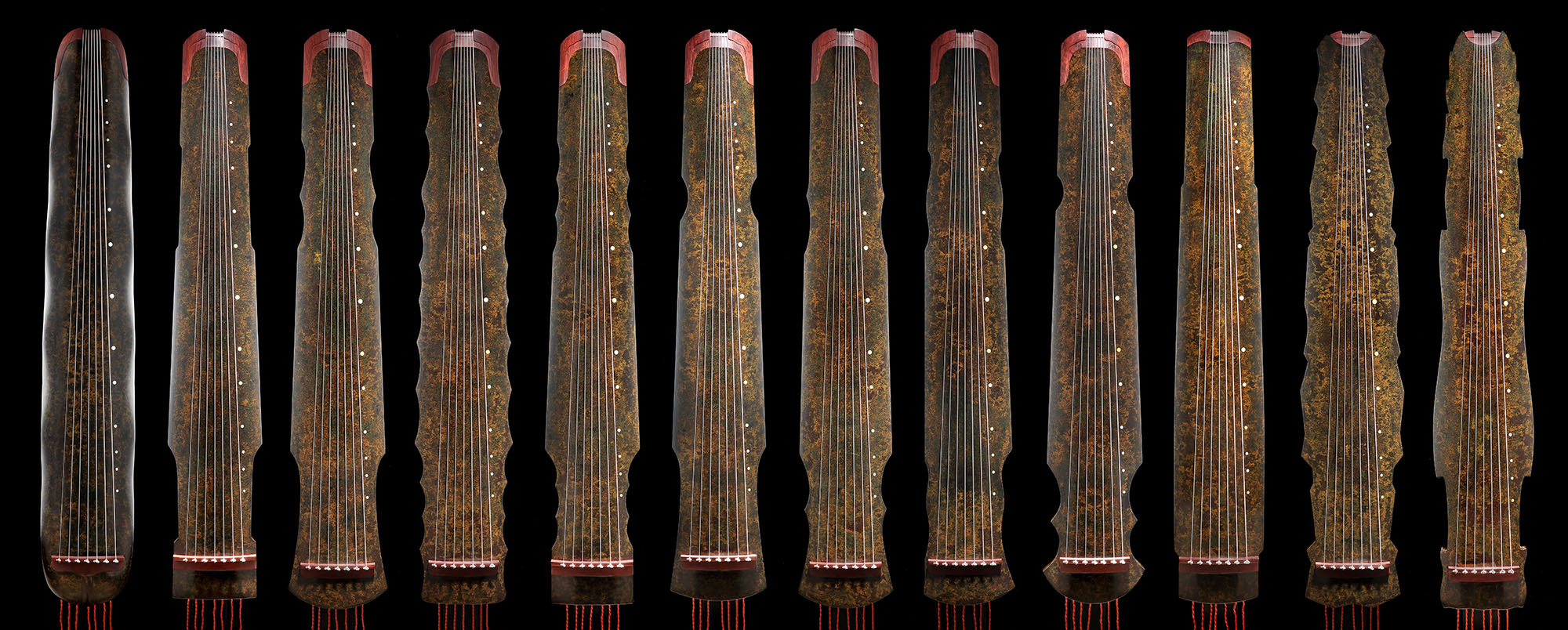
二十四况
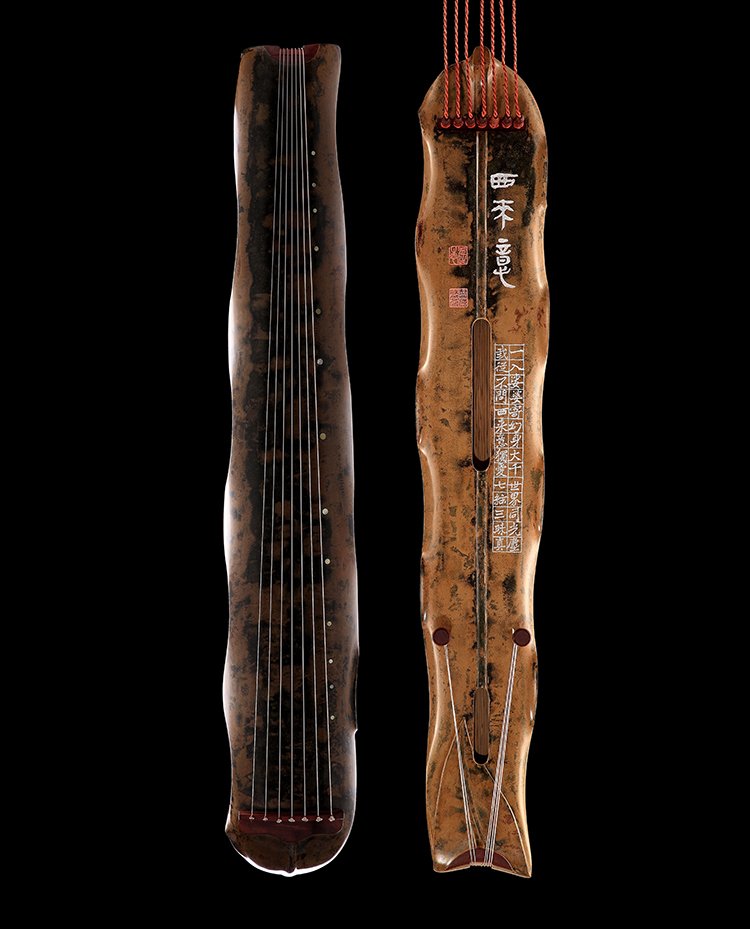
二十四况
◆How the series c ame about
It was recorded in Zun Sheng Ba Jian (Eight Notes on Quality Life) by Gao Lian of the Ming Dynasty that banana leaf style qins were created by Zhu Haihe, the earliest being the qin named “Jiao Lin Tin Yu” (“Listening to the rain in the banana trees”) of the Wanli era of the Ming Dynasty, now collected by the Palace Museum in Beijing. The instrument is shaped like a banana leaf. There are no inside curves at the neck and waist sections. The leaf stem is situated at the head section. Therefore there is only one peg protector. The joining section of the top and bottom boards forms the edge of the banana leaf; therefore there are no distinct side-walls.
Banana Leaf Series (13), aka Banana Leaf Series of 13 chai (ladies), contains 12 newly created banana leaf style qins, plus one crafted on the basis of the traditional banana leaf style qin: “Listening to the rain in the banana trees”. These instruments imitate the shape of banana leaves with an empathy for the vegetation, in the same way as the sky cleared up when Buddha conducted his lessons. Thirty years have elapsed like a dream. As waters flow and flowers fall and as the hourglass empties and bells ring, everything has disappeared into the void in the blink of an eye. I recall the days residing in a temple in the mountains, with the cool moon hanging in the sky and sparsely planted wutong (Chinese parasol) trees in the yard, facing nothing but the old Buddha statues under dim light and listening to the clear sound of the qin music till dawn.
There are a multitude of qin-makers in the world. Their well- and painstakingly crafted qins produce beautiful sounds, an indication of the qin-makers’ excellent skills. As for the difference in thickness and depth of the qin body and the variations in colors and the density of the wood, they correspond with the connoisseurs’ efforts and judgement, far beyond the aptitude of a mere craftsman. The improvement of skills culminates in art.
智藏之治琴,神以合道,虚徐其韵,除烦而去燥,精工而臻美,清思峻骨,生气远出,如在清凉世界。
组琴概况
△组合特点:首创十二款蕉叶形制,加故宫所藏蕉林听雨式,合蕉叶十三式,款式各异,为历代蕉叶造型之大全。
△面板材料:梧桐四张、五千年古楠木两张、两千年古杉木七张。
△品相特点:线条流畅,琴体优美;漆色有生新之意,颇具写意之美;音色古朴醇厚,清远雅正,气象恢宏。
△制作周期:2011年秋造型挂壁,2014年秋全部完成,2015年夏由实力派篆刻家、古琴家清平先生书写并镌刻琴名和铭文。
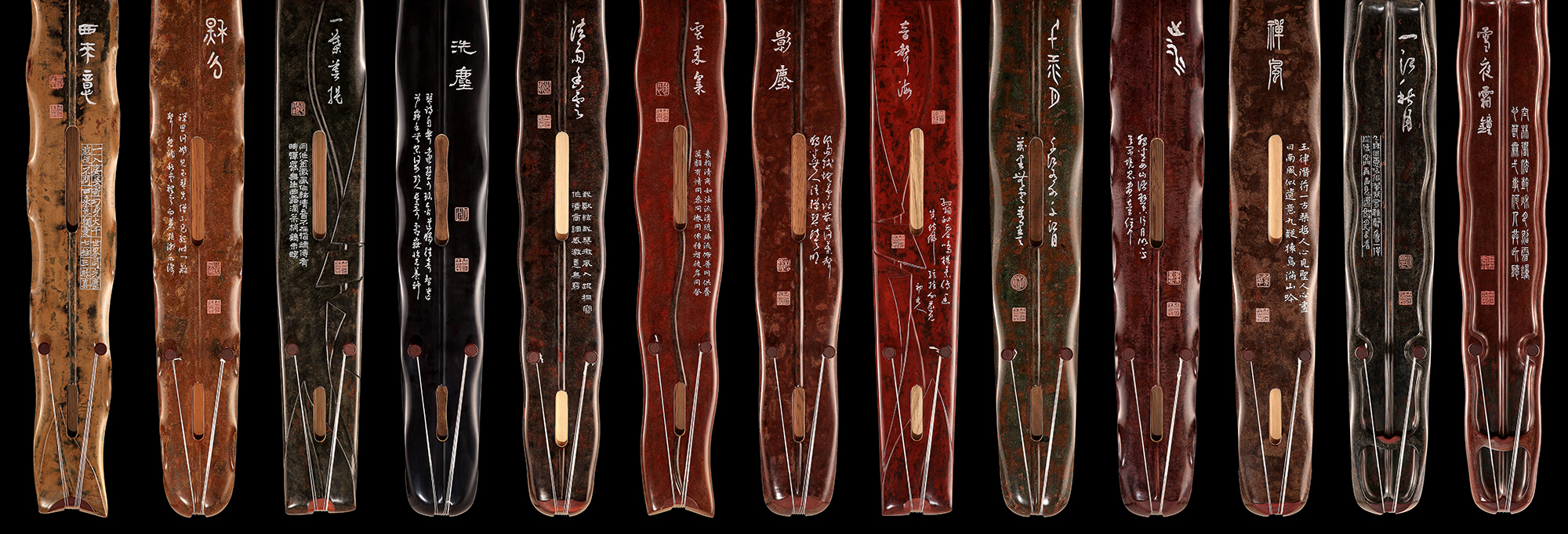
蕉叶十三式

蕉叶十三式
◆组琴缘起
It was recorded in Zun Sheng Ba Jian (Eight Notes on Quality Life) by Gao Lian of the Ming Dynasty that banana leaf style qins were created by Zhu Haihe, the earliest being the qin named “Jiao Lin Tin Yu” (“Listening to the rain in the banana trees”) of the Wanli era of the Ming Dynasty, now collected by the Palace Museum in Beijing. The instrument is shaped like a banana leaf. There are no inside curves at the neck and waist sections. The leaf stem is situated at the head section. Therefore there is only one peg protector. The joining section of the top and bottom boards forms the edge of the banana leaf; therefore there are no distinct side-walls.
Banana Leaf Series (13), aka Banana Leaf Series of 13 chai (ladies), contains 12 newly created banana leaf style qins, plus one crafted on the basis of the traditional banana leaf style qin: “Listening to the rain in the banana trees”. These instruments imitate the shape of banana leaves with an empathy for the vegetation, in the same way as the sky cleared up when Buddha conducted his lessons. Thirty years have elapsed like a dream. As waters flow and flowers fall and as the hourglass empties and bells ring, everything has disappeared into the void in the blink of an eye. I recall the days residing in a temple in the mountains, with the cool moon hanging in the sky and sparsely planted wutong (Chinese parasol) trees in the yard, facing nothing but the old Buddha statues under dim light and listening to the clear sound of the qin music till dawn.
There are a multitude of qin-makers in the world. Their well- and painstakingly crafted qins produce beautiful sounds, an indication of the qin-makers’ excellent skills. As for the difference in thickness and depth of the qin body and the variations in colors and the density of the wood, they correspond with the connoisseurs’ efforts and judgement, far beyond the aptitude of a mere craftsman. The improvement of skills culminates in art.
智藏之治琴,神以合道,虚徐其韵,除烦而去燥,精工而臻美,清思峻骨,生气远出,如在清凉世界。
组琴概况
△组合特点:首创十二款蕉叶形制,加故宫所藏蕉林听雨式,合蕉叶十三式,款式各异,为历代蕉叶造型之大全。
△面板材料:梧桐四张、五千年古楠木两张、两千年古杉木七张。
△品相特点:线条流畅,琴体优美;漆色有生新之意,颇具写意之美;音色古朴醇厚,清远雅正,气象恢宏。
△制作周期:2011年秋造型挂壁,2014年秋全部完成,2015年夏由实力派篆刻家、古琴家清平先生书写并镌刻琴名和铭文。

竹林七闲
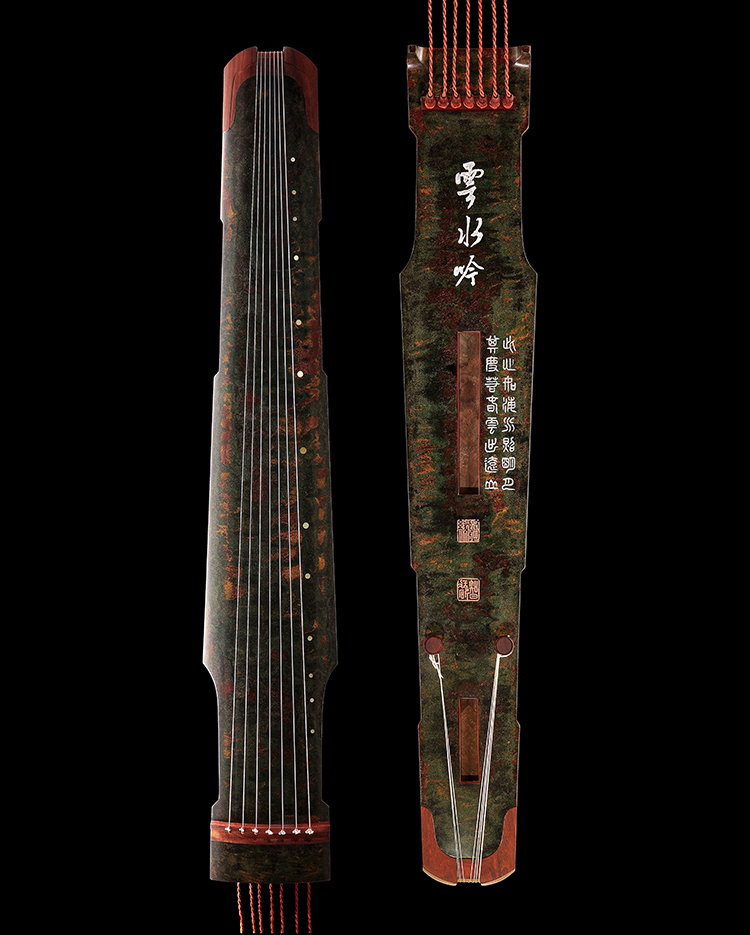
竹林七闲
◆组合缘起:
There were a group of seven Chinese scholars, writers and musicians who lived during the 3rd century CE, commonly referred to as the “(Cao) Wei (state) and Jin (Dynasty) period”). They were known as “the seven sages of the bamboo grove” because they loved to gather in bamboo groves near the house of Ji Kang (one of the seven) in Shanyang (now in Henan province). In admiration of their aspiration for a simple and rustic life, I created the “qi xian” series. Because the Chinese character for “leisure” (閒) sounds the same as “sage” (賢) (both pronounced: xian), I called them “seven leisures”. Some people thought it was a mistake, not knowing that it represented my adoration of their craving for a leisurely life far away from the madding crowd. Why bother asking the Patriarch’s intention in coming from the West, when we can listen to the songs in leisure under the clear moon in the hush of the bamboo groves? My qin-making workshop, Xie Xie Tang, (literary meaning: a hall to take a rest) is located in the suburbs of Shanghai (recently relocated to Kunshan City, Suzhou, near Dianshan Lake) where there are several bamboo groves and a half-acre of lotus pond. Whenever good friends came to visit, we would gather on the lawn outside on the spur of the moment and sit under the bright moon, playing the qin and the shakuhachi (Japanese bamboo) flute till the moon paled in early dawn before turning in. At times like this, I would then take off my robes and lie on the ground half naked. Taking in the aroma of the lotus, I would fall asleep and drift into my sweet dreams on the bank of the pond, feeling like a leisurely visitor of the bamboo grove myself.
组合概况:
△组合特点:择七款经典制式,特调幽绿漆色,集传统斫琴工艺、传统漆艺之精萃。
△面板材料:七张全部双层面板,三百多年老杉木,贴五千年古木百衲;
△底板材料:百年老梓木;
△配件材料:七张全部使用小叶紫檀;
△琴徽材质:螺钿;
△品相特点:款式经典,工艺精湛,品相玄妙;漆色斑驳陆离,气韵高古,尽显大漆之美。
△制作周期:2011年秋造型挂壁,2014年秋全部完成;

竹影禅风
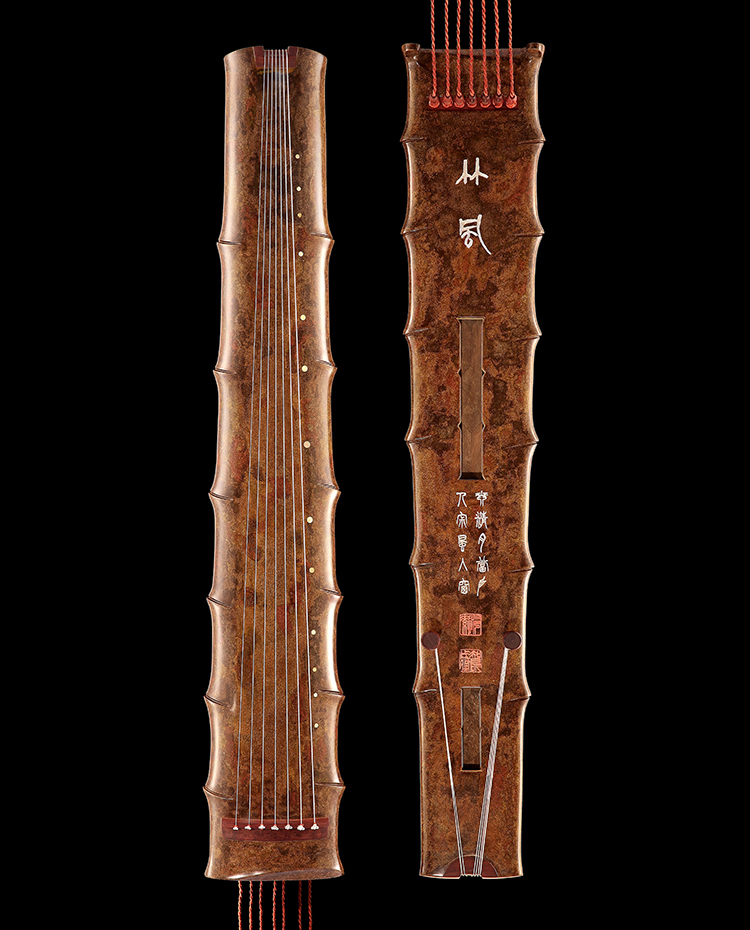
竹影禅风
◆组合缘起:
竹节式,又名此君式、阮竹式,最早见于宋《琴史》,图谱中仅有一款,今人仿之,然多不得其意。余自幼爱竹,早岁斫琴,欲法其形而和之韵,然画竹容易,写神却难,遂作罢。此去经年,余云游九华,住甘露寺,见竹林数顷,翠樾千重,好生欢喜。一日雨后,闲庭漫步,举足若禅,訇然间远山竹断,响澈空宇。一声忽起、倏瞬即灭,正如昨日之日,去之不留。忽然间时空骤转,得忆常住南普陀寺时,早晚以击云板为执事,晨钟暮鼓,四年如一日。每逢月明星稀,睹竹影横斜之相,听风入竹林之声,时轻声萧萧,伴空林法鼓;或疾劲啸鸣,响古寺霜锺。于动静之间,引人入定。依此两地异时之殊胜因缘,遂得竹影禅风之妙,效高节以津大道,法中空而见菩提。笔墨写意,竹韵入琴,于竹茎方寸间,最见神韵,使音色、形制、竹韵之美,具见于琴。
组合概况:
△组合特点:自创七款竹节式古琴,承先师高古遗韵,启竹节琴制新风,补历代古琴图谱之缺,为当代竹节款式大全。
△面板材料:七张全部双层面板,三百多年老杉木,贴五千年古木百衲;
△底板材料:梓木;
△配件材料:七张全部使用小叶紫檀;
△琴徽材质:螺钿;
△品相特点:以水墨入形,淡墨轻岚为一体,风骨盎然;以工笔调色,随类敷色,层层渲染,竹韵生动。音色清远雅正,独标高格。
△制作周期:2011年秋造型挂壁,2014年秋全部完成;
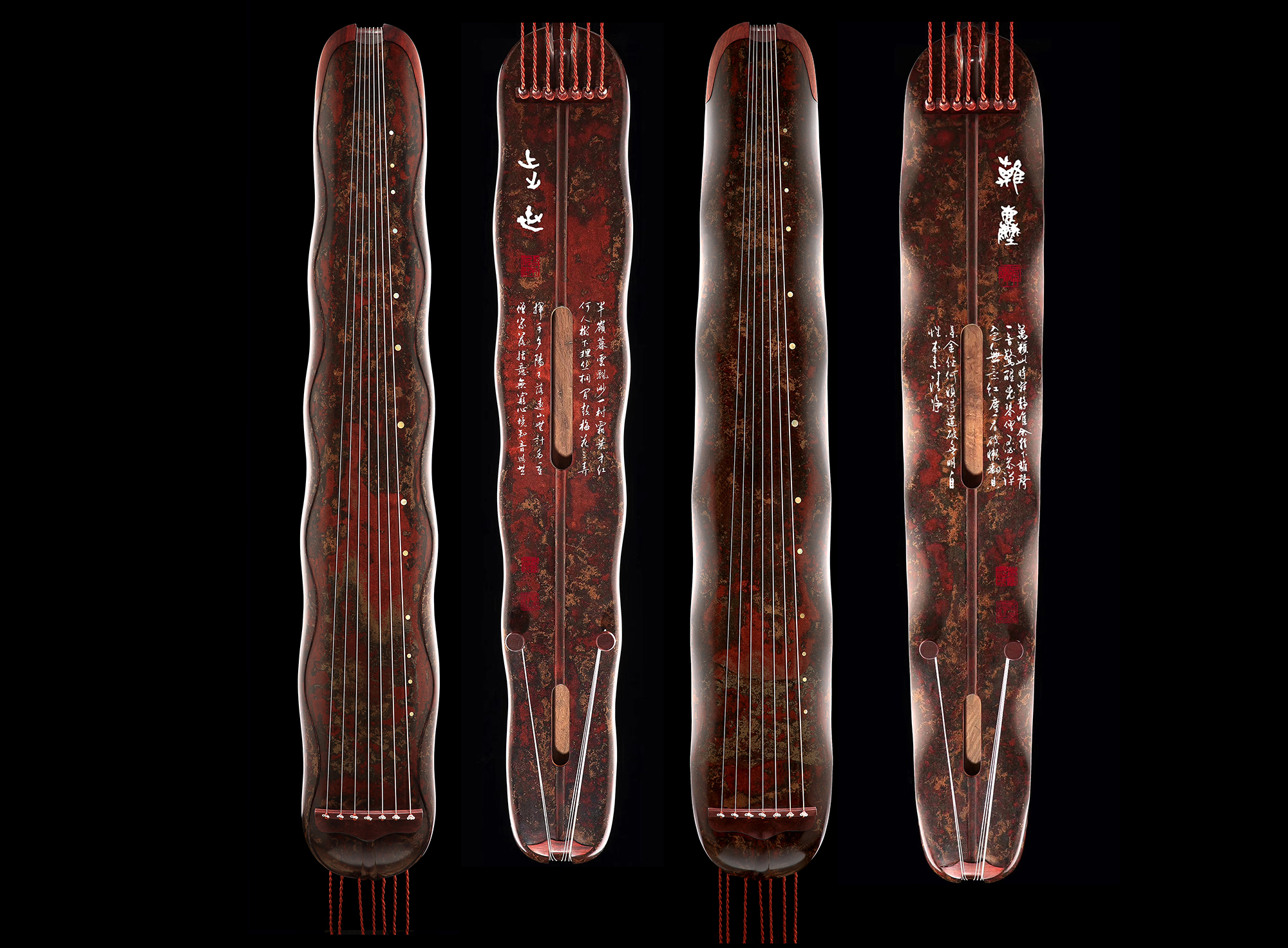
二圣谛
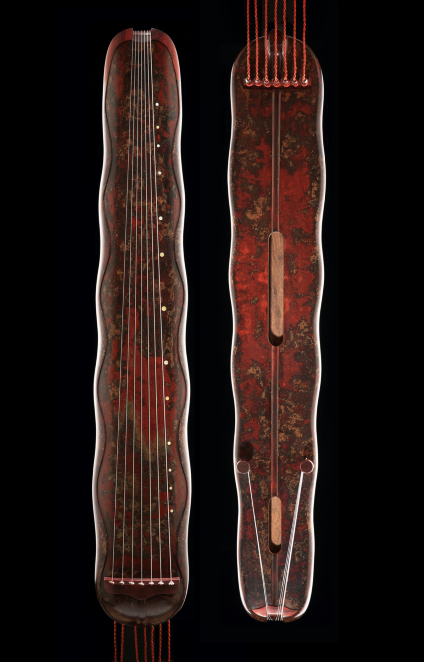
二圣谛
◆How the series came about:
Zhujie (bamboo joint) style, also called Cijun (this gentleman) style or Ruanzhu (bamboo) style, the earliest record of this style of qin is found in The History of Qin of the Song Dynasty. There is only one sample in the illustrations. Although widely copied today, many have failed to get the essence of it. I have had a love for bamboo since my childhood. When I first started making qins, I tried at one time to copy the shape to get the harmonious sound. But it was easier said than done. While I could get the appearance right, I failed to get the spirit. Finally, I gave that up. Years went by until I traveled to Mount Jiuhua and stayed at Ganlu Monastery, where there were acres of bamboo groves. Their graceful evergreen foliage expands to my greatest delight. One day, I took a leisurely walk in the bamboo groves after the rain, one light step after another as if in Zen cultivation. All of a sudden, I heard the cracking of bamboos in the distance, which echoed in the thin air. An abrupt sound that instantly disappears is like the passing of yesterday: once it was gone, it was gone forever. Suddenly, time seemed to have traveled back to the days when I was living at the South Putuo Monastery in the southern Chinese city of Xiamen, where I took up the task of striking umpan or yun ban (literally translated “cloud plate” for the purpose of reporting time) in the mornings and at nights for four years. During clear star-lit nights, not only could I see the swinging bamboos in the moon light but also hear the sound of the clear wind as it blew through the bamboo groves, sometimes whispering softly to the accompaniment of the sound of the dharma drums and sometimes shrieking loudly, ringing the bells in the old temple. I was ushered into concentration between the silence and the sound. The unusual experiences at these two different places gave me the inspiration about how to craft the bamboo shadow series, to promote the great Way by modeling the qin on the gaojie (literally “high joints” and figuratively “high nobility”) of the bamboo and to exhibit Bodhi by imitating the zhongkong (literally “hollow in the middle” and figuratively the Buddhist concept of “space” or “median void”) of the bamboo. To show the spirit of bamboo in qin, the inch-long bamboo joints are most critical. It should be demonstrated in the same way as in Chinese painting, emphasising the spirit. Only then, the sound, the shape and the beauty of the bamboo’s zest are all represented in the musical instrument.
组合概况:
△组合特点:自创七款竹节式古琴,承先师高古遗韵,启竹节琴制新风,补历代古琴图谱之缺,为当代竹节款式大全。
△面板材料:七张全部双层面板,三百多年老杉木,贴五千年古木百衲;
△底板材料:梓木;
△配件材料:七张全部使用小叶紫檀;
△琴徽材质:螺钿;
△品相特点:以水墨入形,淡墨轻岚为一体,风骨盎然;以工笔调色,随类敷色,层层渲染,竹韵生动。音色清远雅正,独标高格。
△制作周期:2011年秋造型挂壁,2014年秋全部完成;
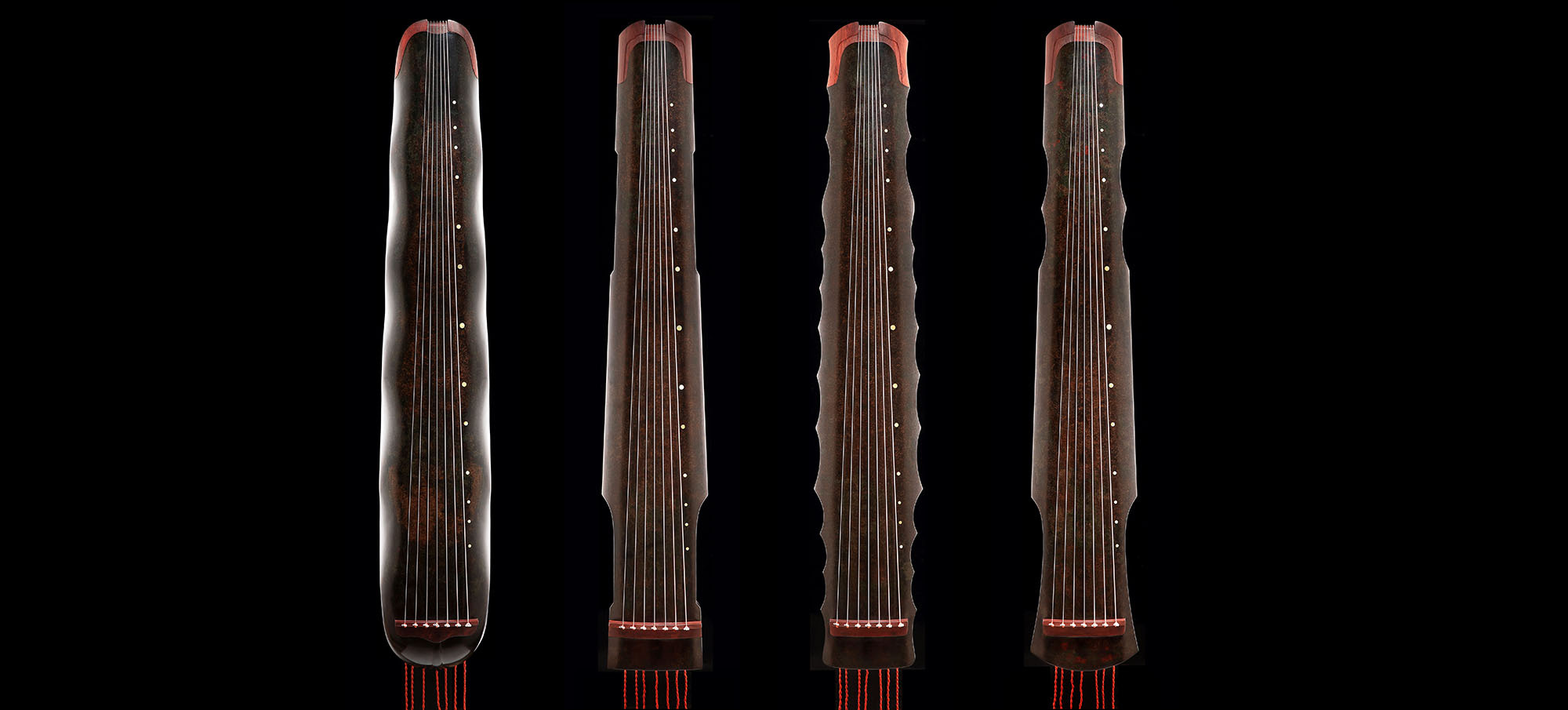
四无量心
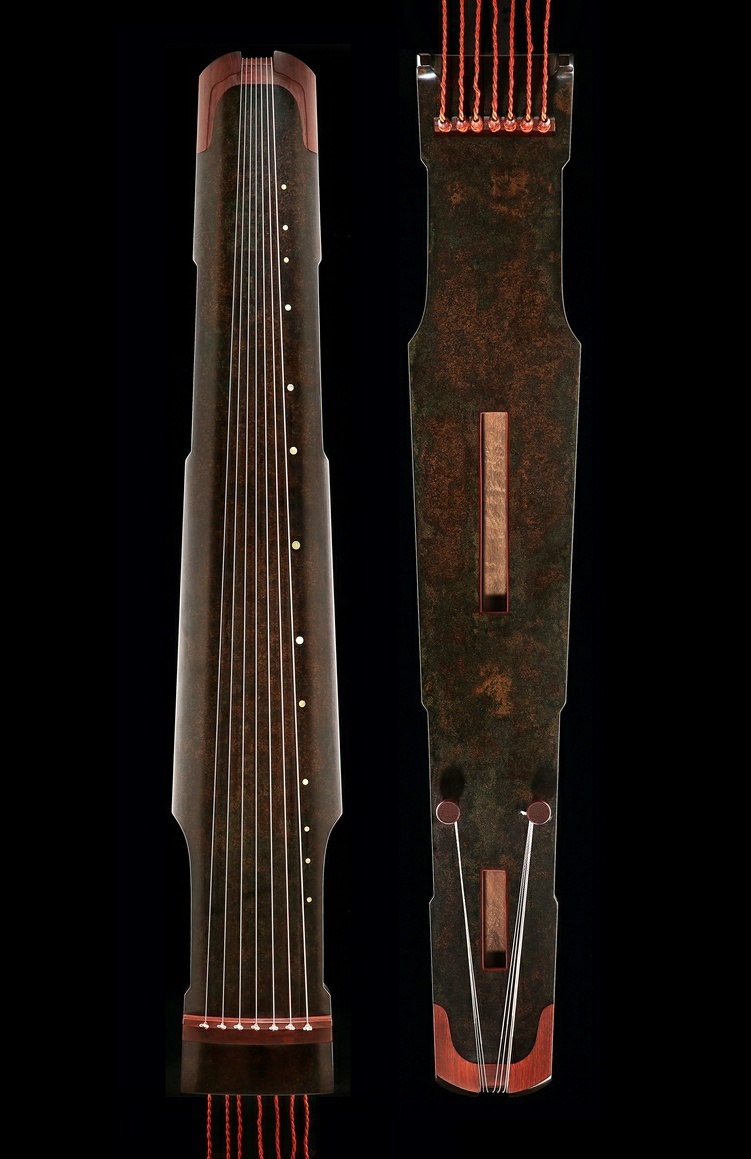
四无量心
◆组合缘起:
Zhujie (bamboo joint) style, also called Cijun (this gentleman) style or Ruanzhu (bamboo) style, the earliest record of this style of qin is found in The History of Qin of the Song Dynasty. There is only one sample in the illustrations. Although widely copied today, many have failed to get the essence of it. I have had a love for bamboo since my childhood. When I first started making qins, I tried at one time to copy the shape to get the harmonious sound. But it was easier said than done. While I could get the appearance right, I failed to get the spirit. Finally, I gave that up. Years went by until I traveled to Mount Jiuhua and stayed at Ganlu Monastery, where there were acres of bamboo groves. Their graceful evergreen foliage expands to my greatest delight. One day, I took a leisurely walk in the bamboo groves after the rain, one light step after another as if in Zen cultivation. All of a sudden, I heard the cracking of bamboos in the distance, which echoed in the thin air. An abrupt sound that instantly disappears is like the passing of yesterday: once it was gone, it was gone forever. Suddenly, time seemed to have traveled back to the days when I was living at the South Putuo Monastery in the southern Chinese city of Xiamen, where I took up the task of striking umpan or yun ban (literally translated “cloud plate” for the purpose of reporting time) in the mornings and at nights for four years. During clear star-lit nights, not only could I see the swinging bamboos in the moon light but also hear the sound of the clear wind as it blew through the bamboo groves, sometimes whispering softly to the accompaniment of the sound of the dharma drums and sometimes shrieking loudly, ringing the bells in the old temple. I was ushered into concentration between the silence and the sound. The unusual experiences at these two different places gave me the inspiration about how to craft the bamboo shadow series, to promote the great Way by modeling the qin on the gaojie (literally “high joints” and figuratively “high nobility”) of the bamboo and to exhibit Bodhi by imitating the zhongkong (literally “hollow in the middle” and figuratively the Buddhist concept of “space” or “median void”) of the bamboo. To show the spirit of bamboo in qin, the inch-long bamboo joints are most critical. It should be demonstrated in the same way as in Chinese painting, emphasising the spirit. Only then, the sound, the shape and the beauty of the bamboo’s zest are all represented in the musical instrument.
组合概况:
△组合特点:自创七款竹节式古琴,承先师高古遗韵,启竹节琴制新风,补历代古琴图谱之缺,为当代竹节款式大全。
△面板材料:七张全部双层面板,三百多年老杉木,贴五千年古木百衲;
△底板材料:梓木;
△配件材料:七张全部使用小叶紫檀;
△琴徽材质:螺钿;
△品相特点:以水墨入形,淡墨轻岚为一体,风骨盎然;以工笔调色,随类敷色,层层渲染,竹韵生动。音色清远雅正,独标高格。
△制作周期:2011年秋造型挂壁,2014年秋全部完成;
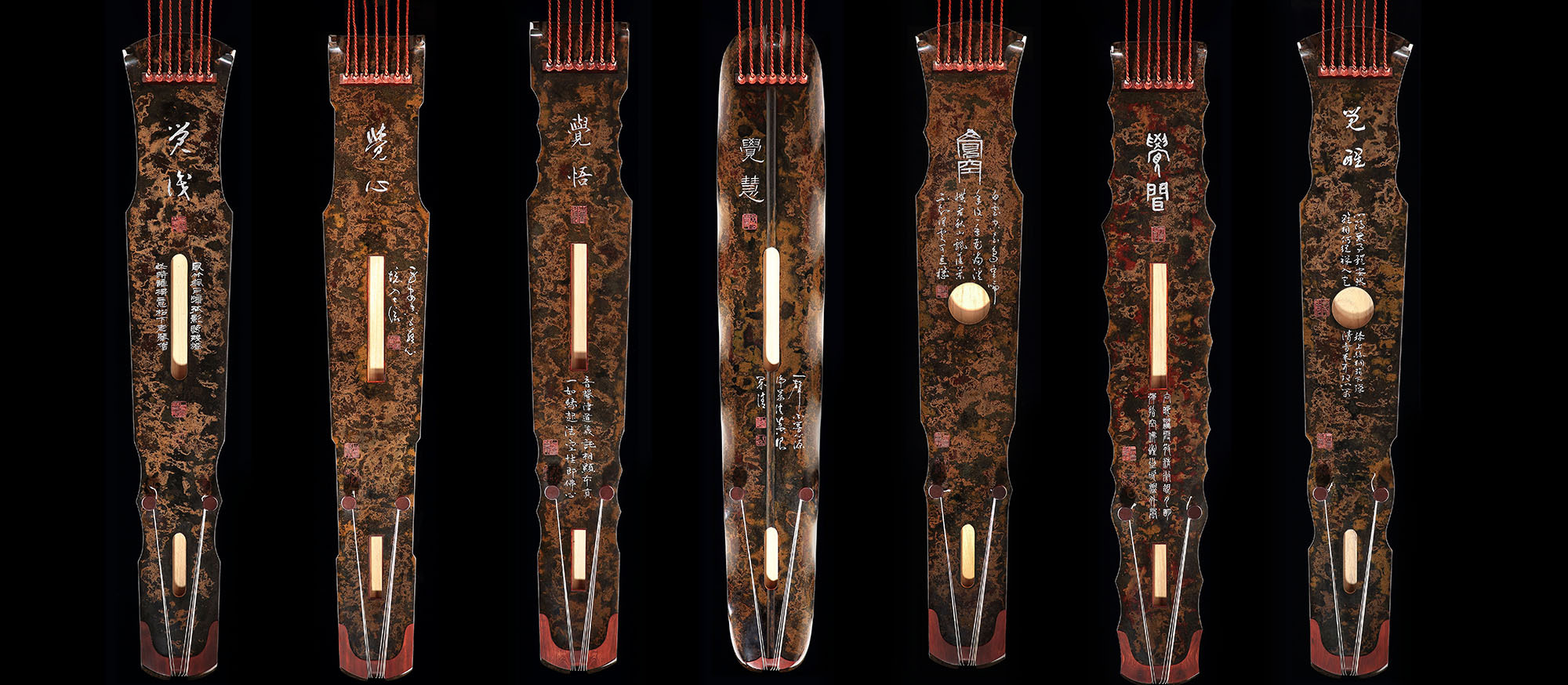
七觉支
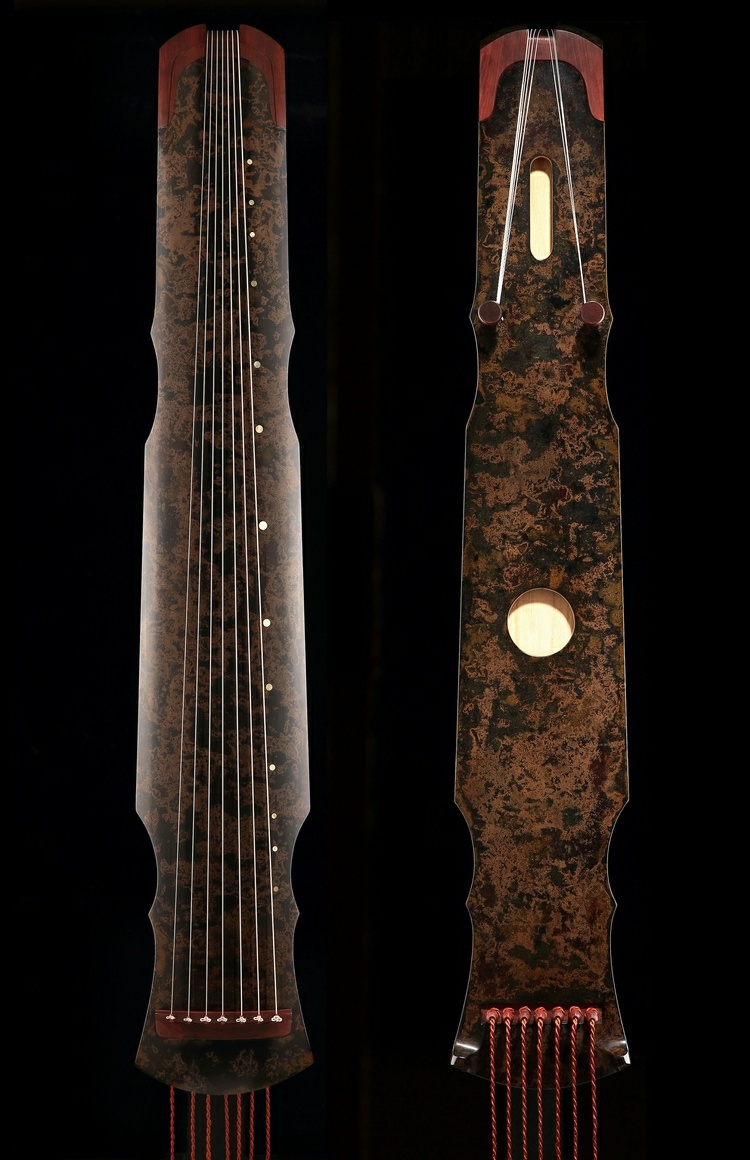
七觉支
◆组合缘起:
竹节式,又名此君式、阮竹式,最早见于宋《琴史》,图谱中仅有一款,今人仿之,然多不得其意。余自幼爱竹,早岁斫琴,欲法其形而和之韵,然画竹容易,写神却难,遂作罢。此去经年,余云游九华,住甘露寺,见竹林数顷,翠樾千重,好生欢喜。一日雨后,闲庭漫步,举足若禅,訇然间远山竹断,响澈空宇。一声忽起、倏瞬即灭,正如昨日之日,去之不留。忽然间时空骤转,得忆常住南普陀寺时,早晚以击云板为执事,晨钟暮鼓,四年如一日。每逢月明星稀,睹竹影横斜之相,听风入竹林之声,时轻声萧萧,伴空林法鼓;或疾劲啸鸣,响古寺霜锺。于动静之间,引人入定。依此两地异时之殊胜因缘,遂得竹影禅风之妙,效高节以津大道,法中空而见菩提。笔墨写意,竹韵入琴,于竹茎方寸间,最见神韵,使音色、形制、竹韵之美,具见于琴。
组合概况:
△组合特点:自创七款竹节式古琴,承先师高古遗韵,启竹节琴制新风,补历代古琴图谱之缺,为当代竹节款式大全。
△面板材料:七张全部双层面板,三百多年老杉木,贴五千年古木百衲;
△底板材料:梓木;
△配件材料:七张全部使用小叶紫檀;
△琴徽材质:螺钿;
△品相特点:以水墨入形,淡墨轻岚为一体,风骨盎然;以工笔调色,随类敷色,层层渲染,竹韵生动。音色清远雅正,独标高格。
△制作周期:2011年秋造型挂壁,2014年秋全部完成;
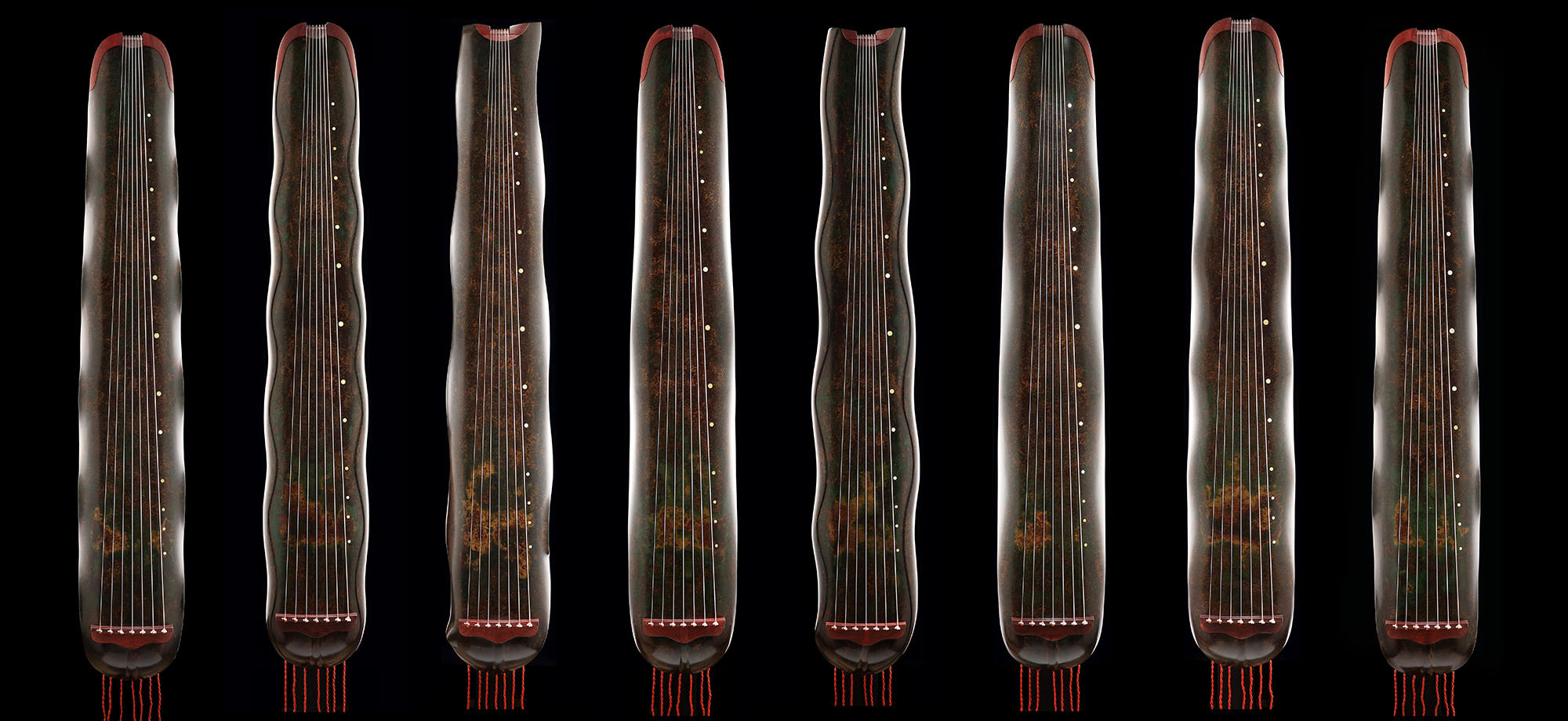
八正道
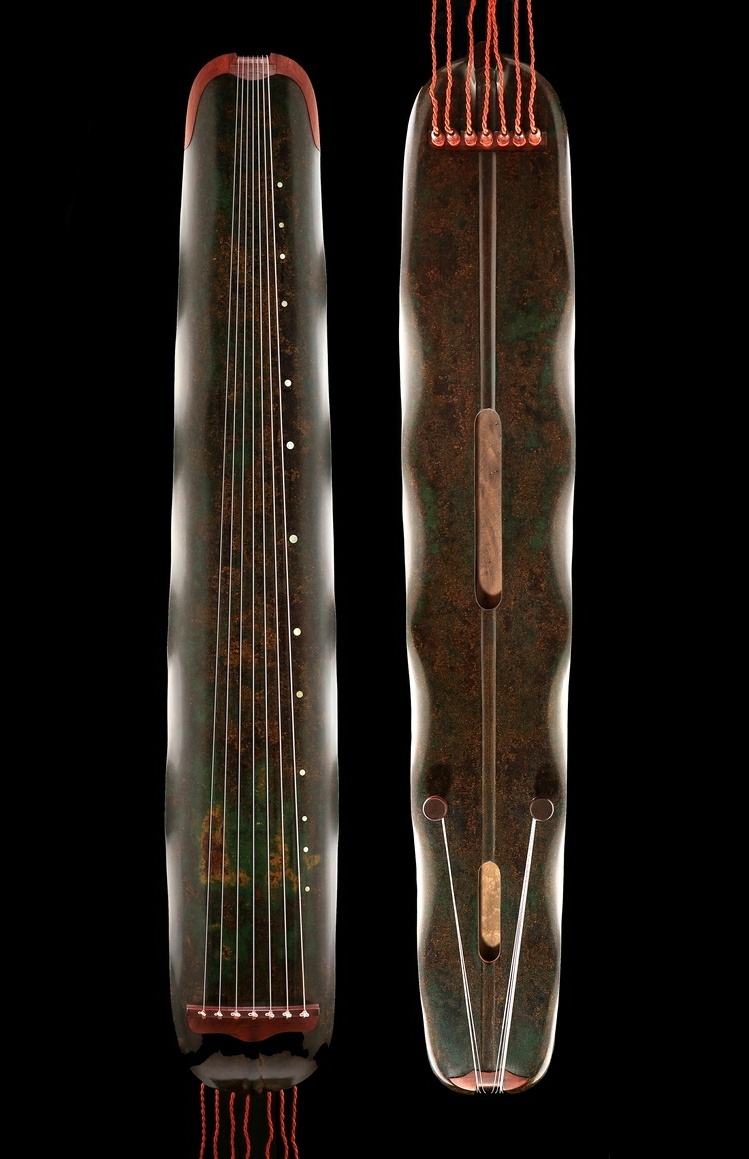
八正道
◆组合缘起:
竹节式,又名此君式、阮竹式,最早见于宋《琴史》,图谱中仅有一款,今人仿之,然多不得其意。余自幼爱竹,早岁斫琴,欲法其形而和之韵,然画竹容易,写神却难,遂作罢。此去经年,余云游九华,住甘露寺,见竹林数顷,翠樾千重,好生欢喜。一日雨后,闲庭漫步,举足若禅,訇然间远山竹断,响澈空宇。一声忽起、倏瞬即灭,正如昨日之日,去之不留。忽然间时空骤转,得忆常住南普陀寺时,早晚以击云板为执事,晨钟暮鼓,四年如一日。每逢月明星稀,睹竹影横斜之相,听风入竹林之声,时轻声萧萧,伴空林法鼓;或疾劲啸鸣,响古寺霜锺。于动静之间,引人入定。依此两地异时之殊胜因缘,遂得竹影禅风之妙,效高节以津大道,法中空而见菩提。笔墨写意,竹韵入琴,于竹茎方寸间,最见神韵,使音色、形制、竹韵之美,具见于琴。
组合概况:
△组合特点:自创七款竹节式古琴,承先师高古遗韵,启竹节琴制新风,补历代古琴图谱之缺,为当代竹节款式大全。
△面板材料:七张全部双层面板,三百多年老杉木,贴五千年古木百衲;
△底板材料:梓木;
△配件材料:七张全部使用小叶紫檀;
△琴徽材质:螺钿;
△品相特点:以水墨入形,淡墨轻岚为一体,风骨盎然;以工笔调色,随类敷色,层层渲染,竹韵生动。音色清远雅正,独标高格。
△制作周期:2011年秋造型挂壁,2014年秋全部完成;
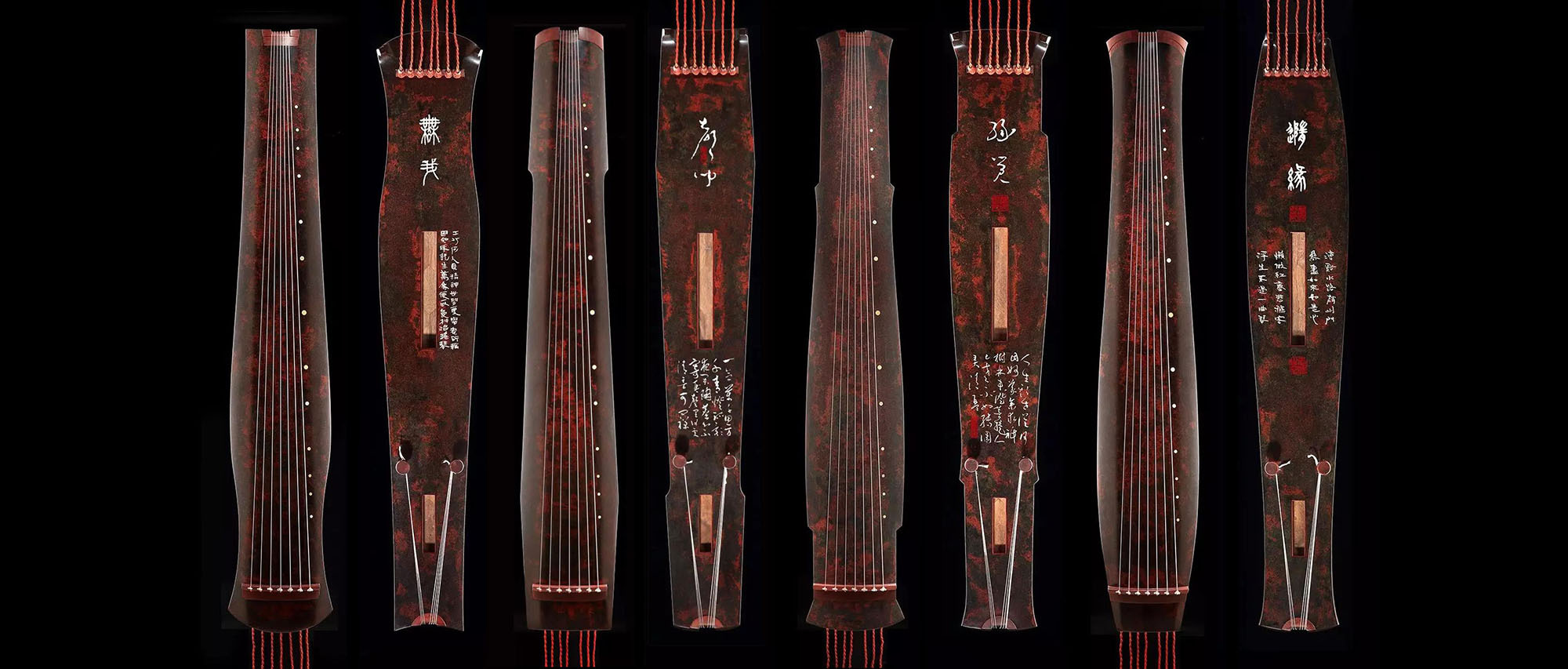
四正勤
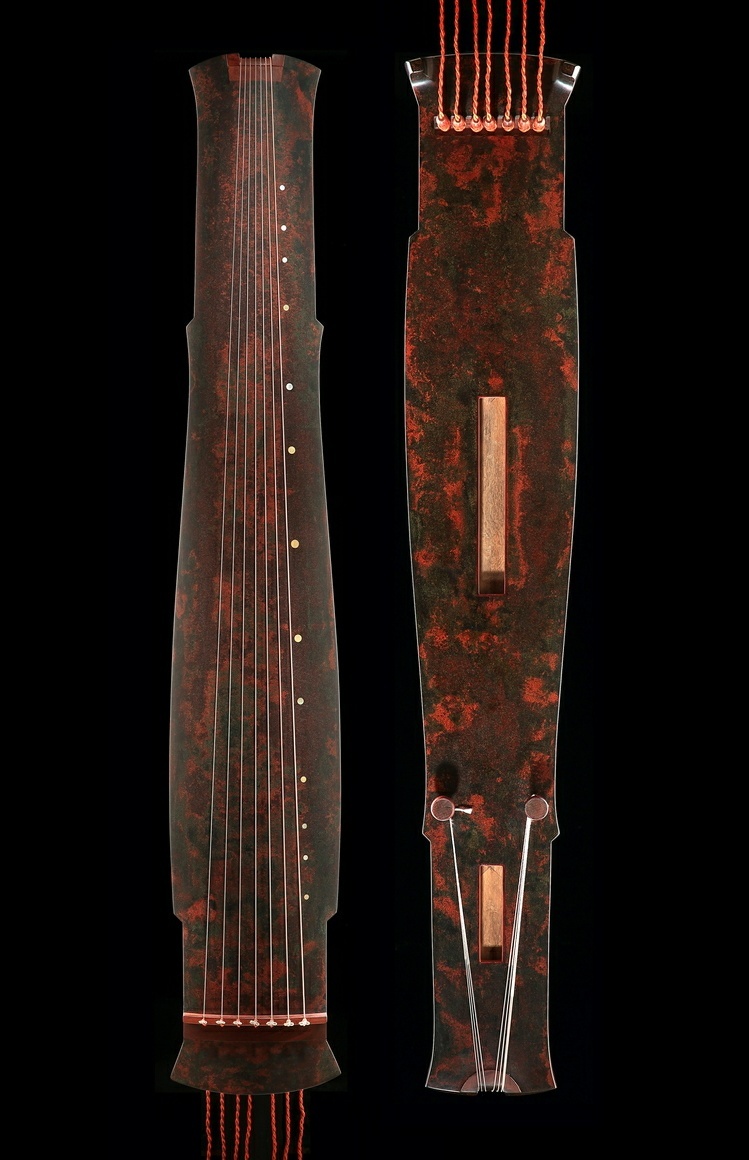
四正勤
◆组合缘起:
竹节式,又名此君式、阮竹式,最早见于宋《琴史》,图谱中仅有一款,今人仿之,然多不得其意。余自幼爱竹,早岁斫琴,欲法其形而和之韵,然画竹容易,写神却难,遂作罢。此去经年,余云游九华,住甘露寺,见竹林数顷,翠樾千重,好生欢喜。一日雨后,闲庭漫步,举足若禅,訇然间远山竹断,响澈空宇。一声忽起、倏瞬即灭,正如昨日之日,去之不留。忽然间时空骤转,得忆常住南普陀寺时,早晚以击云板为执事,晨钟暮鼓,四年如一日。每逢月明星稀,睹竹影横斜之相,听风入竹林之声,时轻声萧萧,伴空林法鼓;或疾劲啸鸣,响古寺霜锺。于动静之间,引人入定。依此两地异时之殊胜因缘,遂得竹影禅风之妙,效高节以津大道,法中空而见菩提。笔墨写意,竹韵入琴,于竹茎方寸间,最见神韵,使音色、形制、竹韵之美,具见于琴。
组合概况:
△组合特点:自创七款竹节式古琴,承先师高古遗韵,启竹节琴制新风,补历代古琴图谱之缺,为当代竹节款式大全。
△面板材料:七张全部双层面板,三百多年老杉木,贴五千年古木百衲;
△底板材料:梓木;
△配件材料:七张全部使用小叶紫檀;
△琴徽材质:螺钿;
△品相特点:以水墨入形,淡墨轻岚为一体,风骨盎然;以工笔调色,随类敷色,层层渲染,竹韵生动。音色清远雅正,独标高格。
△制作周期:2011年秋造型挂壁,2014年秋全部完成;
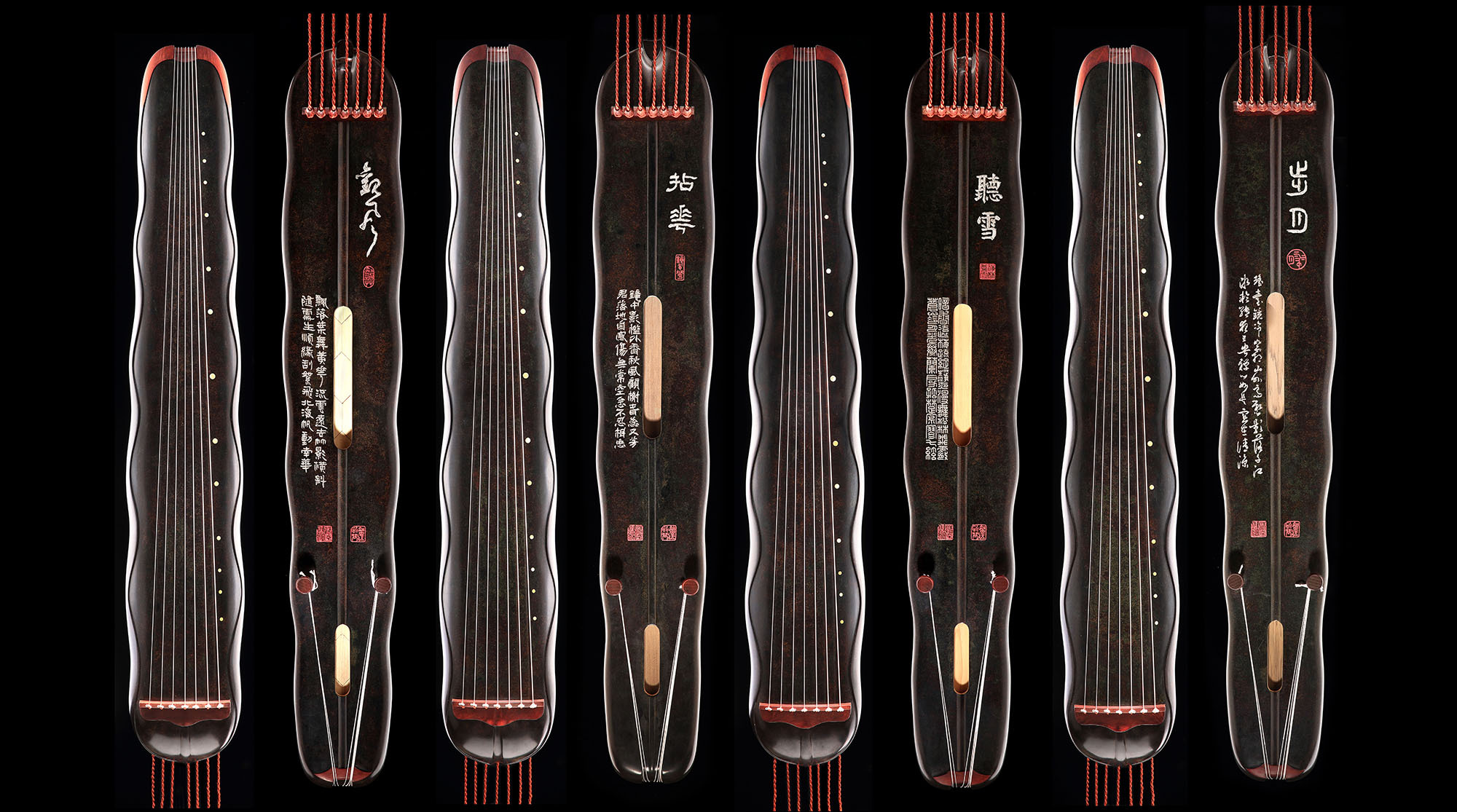
風花雪月

風花雪月
◆组合缘起:
竹节式,又名此君式、阮竹式,最早见于宋《琴史》,图谱中仅有一款,今人仿之,然多不得其意。余自幼爱竹,早岁斫琴,欲法其形而和之韵,然画竹容易,写神却难,遂作罢。此去经年,余云游九华,住甘露寺,见竹林数顷,翠樾千重,好生欢喜。一日雨后,闲庭漫步,举足若禅,訇然间远山竹断,响澈空宇。一声忽起、倏瞬即灭,正如昨日之日,去之不留。忽然间时空骤转,得忆常住南普陀寺时,早晚以击云板为执事,晨钟暮鼓,四年如一日。每逢月明星稀,睹竹影横斜之相,听风入竹林之声,时轻声萧萧,伴空林法鼓;或疾劲啸鸣,响古寺霜锺。于动静之间,引人入定。依此两地异时之殊胜因缘,遂得竹影禅风之妙,效高节以津大道,法中空而见菩提。笔墨写意,竹韵入琴,于竹茎方寸间,最见神韵,使音色、形制、竹韵之美,具见于琴。
组合概况:
△组合特点:自创七款竹节式古琴,承先师高古遗韵,启竹节琴制新风,补历代古琴图谱之缺,为当代竹节款式大全。
△面板材料:七张全部双层面板,三百多年老杉木,贴五千年古木百衲;
△底板材料:梓木;
△配件材料:七张全部使用小叶紫檀;
△琴徽材质:螺钿;
△品相特点:以水墨入形,淡墨轻岚为一体,风骨盎然;以工笔调色,随类敷色,层层渲染,竹韵生动。音色清远雅正,独标高格。
△制作周期:2011年秋造型挂壁,2014年秋全部完成;
